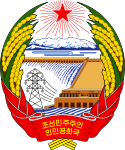Elections in North Korea: Difference between revisions
m Dating maintenance tags: {{Cn}} |
|||
| Line 3: | Line 3: | ||
All seats are won by the [[Democratic Front for the Reunification of the Fatherland]].<ref name="reuters"/> The [[Workers' Party of Korea]] dominates the Front and held 87.5% of the seats, with 7.4% for the [[Korean Social Democratic Party]], 3.2% for the [[Chondoist Chongu Party]], and 1.9% for independent deputies.<ref name=parlunion5>{{cite web|title=The Parliamentary System of the Democratic People's Republic of Korea | publisher= Association of Secretaries General of Parliaments (ASGP) of the [[Inter-Parliamentary Union]] | work=Constitutional and Parliamentary Information | url=http://www.asgp.info/Resources/Data/Documents/CJOZSZTEPVVOCWJVUPPZVWPAPUOFGF.pdf |format=PDF| accessdate=2010-10-1 |page=5|archiveurl=http://wayback.archive.org/web/20120303054935/http://www.asgp.info/Resources/Data/Documents/CJOZSZTEPVVOCWJVUPPZVWPAPUOFGF.pdf|archivedate=20120303}}</ref> According to official reports, turnout is near 100%, and approval of the Democratic Front's candidates is unanimous or nearly so.<ref name=pk/> |
All seats are won by the [[Democratic Front for the Reunification of the Fatherland]].<ref name="reuters"/> The [[Workers' Party of Korea]] dominates the Front and held 87.5% of the seats, with 7.4% for the [[Korean Social Democratic Party]], 3.2% for the [[Chondoist Chongu Party]], and 1.9% for independent deputies.<ref name=parlunion5>{{cite web|title=The Parliamentary System of the Democratic People's Republic of Korea | publisher= Association of Secretaries General of Parliaments (ASGP) of the [[Inter-Parliamentary Union]] | work=Constitutional and Parliamentary Information | url=http://www.asgp.info/Resources/Data/Documents/CJOZSZTEPVVOCWJVUPPZVWPAPUOFGF.pdf |format=PDF| accessdate=2010-10-1 |page=5|archiveurl=http://wayback.archive.org/web/20120303054935/http://www.asgp.info/Resources/Data/Documents/CJOZSZTEPVVOCWJVUPPZVWPAPUOFGF.pdf|archivedate=20120303}}</ref> According to official reports, turnout is near 100%, and approval of the Democratic Front's candidates is unanimous or nearly so.<ref name=pk/> |
||
[[File:Mansudae Grand Monument 08.JPG]] |
|||
==Procedure== |
==Procedure== |
||
Revision as of 18:46, 9 June 2013
 |
|---|
|
|
Elections in North Korea are held every five years. At the national level, North Koreans elect a legislature, the Supreme People's Assembly (SPA). In addition to the Supreme People's Assembly, the people elect representatives to city, county, and provincial "people's assemblies".[1][2]
All seats are won by the Democratic Front for the Reunification of the Fatherland.[3] The Workers' Party of Korea dominates the Front and held 87.5% of the seats, with 7.4% for the Korean Social Democratic Party, 3.2% for the Chondoist Chongu Party, and 1.9% for independent deputies.[4] According to official reports, turnout is near 100%, and approval of the Democratic Front's candidates is unanimous or nearly so.[1]
Procedure
In reply to a question put forth by Michael Marshall, Li Chun Sik of North Korea stated at a meeting of the Association of Secretaries General of Parliaments (ASGP) of the Inter-Parliamentary Union:[5]
While candidates could be nominated by anyone, it was the practice for all candidates to be nominated by the parties. These nominations were examined by the [Democratic Front for the Reunification of the Fatherland] and then by the Central Electoral Committee, which allocated candidates to seats. The candidate in each seat was then considered by the electors in meetings at the workplace or similar, and on election day the electors could then indicate approval or disapproval of the candidate on the ballot paper.
Only one candidate appears on the ballot.[6][7] Elections are ostensibly conducted by secret ballot, and a voter may cross off the candidate's name to vote against him, but must do so in a special booth without any secrecy.[6]
Members of the Supreme People's Assembly are elected to five-year terms, and meet for SPA sessions up to ten days per year.[1] The Supreme People's Assembly elects a standing committee known as the Presidium, which exercises legislative functions when the Assembly is not in session. It also elects the Chairman of the National Defence Commission, the country's chief executive, and the Premier.
Criticism
The elections are essentially show elections, or alternatively, a type of veto election.[citation needed] Seats are uncontested (or alternatively, uncompetitive) as all candidates are chosen and won by the Democratic Front for the Reunification of the Fatherland.[3][5][7]
A voter may cross off the candidate's name to vote against him, but must do so in a special booth without any secrecy; according to many North Korean defectors, such an act of defiance is too risky to even attempt.[6]
Latest election
The latest election was held on March 8, 2009. The following day, North Korean media announced that Kim Jong-il was unanimously re-elected to parliament, though none of his sons were among the appointments.[8] The election committee also stated that 99.98% of all registered voters took part in voting, with 100% voting for their candidate in each district.[9] All seats were won by the Democratic Front for the Reunification of the Fatherland, under the control of the Worker's Party.[3]
Past elections
See also
- Electoral calendar
- Electoral system
- List of Korea-related topics
- Politics of North Korea
- Show election
References
- ^ a b "DPRK Holds Election of Local and National Assemblies". People's Korea. Archived from the original on 20130331. Retrieved 2008-06-28.
{{cite web}}: Check date values in:|archivedate=(help); Unknown parameter|deadurl=ignored (|url-status=suggested) (help) - ^ "The Parliamentary System of the Democratic People's Republic of Korea" (PDF). Constitutional and Parliamentary Information. Association of Secretaries General of Parliaments (ASGP) of the Inter-Parliamentary Union. p. 4. Retrieved 2010-10-1.
{{cite web}}: Check date values in:|accessdate=(help) - ^ a b c Moon, Angela (8 March 2009). "N.Korea vote may point to Kim successor". Reuters. Retrieved 2009-03-08.
{{cite news}}: Unknown parameter|coauthors=ignored (|author=suggested) (help) - ^ "The Parliamentary System of the Democratic People's Republic of Korea" (PDF). Constitutional and Parliamentary Information. Association of Secretaries General of Parliaments (ASGP) of the Inter-Parliamentary Union. p. 5. Archived from the original (PDF) on 20120303. Retrieved 2010-10-1.
{{cite web}}: Check date values in:|accessdate=and|archivedate=(help) - ^ a b "The Parliamentary System of the Democratic People's Republic of Korea" (PDF). Constitutional and Parliamentary Information. Association of Secretaries General of Parliaments (ASGP) of the Inter-Parliamentary Union. pp. 17–18. Retrieved 2010-10-01.
- ^ a b c "North Korea votes for new rubber-stamp parliament". Associated Press. 8 March 2009.
- ^ a b "Kim wins re-election with 99.9% of the vote". The New York Times. 9 March 2009.
- ^ "N Korea polls 'give no clue'". Press Association. 9 March 2009.
- ^ "N Korea's Kim wins parliamentary seat: official media". AFP. 9 March 2009.
